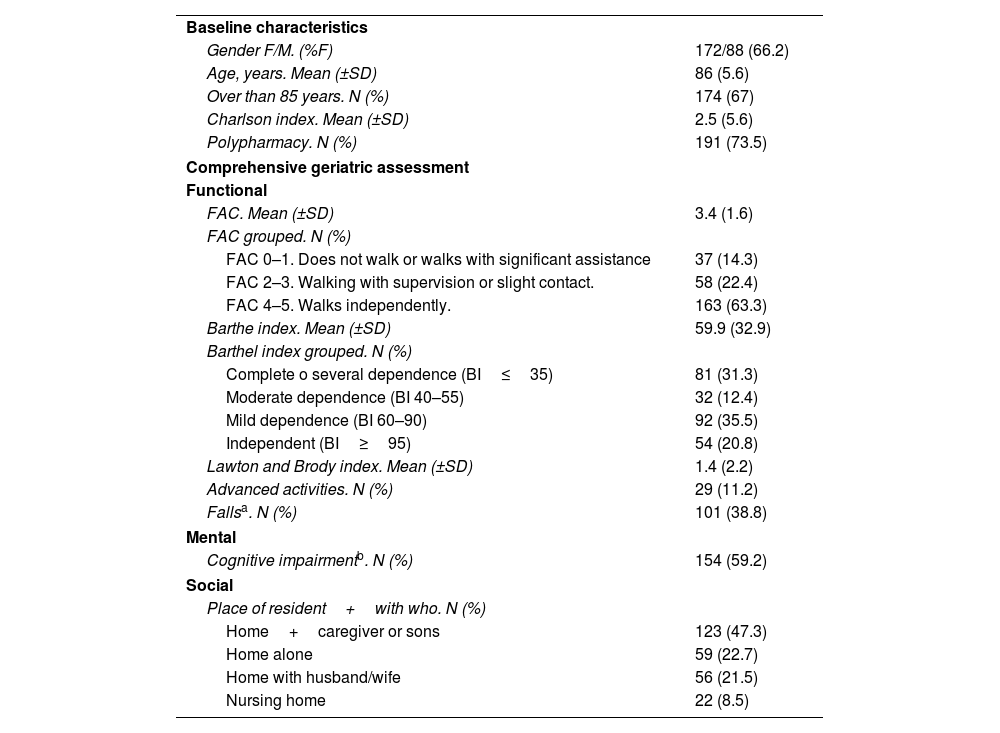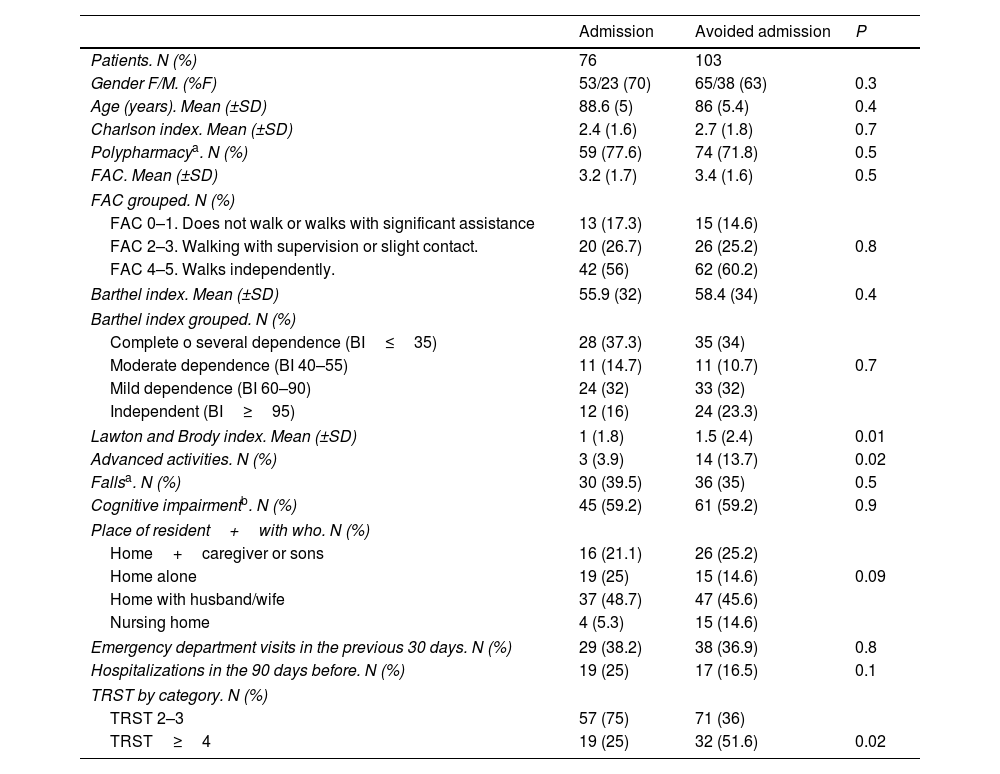To know the impact of a geriatric intervention based on the Comprehensive Geriatric Assessment (CGA) on avoidable admissions in older patients at risk evaluated in the Emergency Department.
MethodProspective observational unicenter study. We included patients, from October 1, 2018 to January 31, 2020, over 75 years who were attended at the Emergency Department with a Triage Risk Screening Tool (TRST) score≥2. All patients were evaluated by a geriatrician through the CGA. The reasons for going to the Emergency room were collected and also the main intervention carried out by Geriatrics, whether admission or discharge was indicated and whether the admission was avoidable. We did a cost analysis calculating this by (bed/day×average stay×number of admissions avoided).
ResultsWe included 260 patients, 66% were women and the mean age was 86 years. 73.5% patients had polypharmacy, the mean Charlson index was 2.5 (5.6). 63.3% were independent for walking and 20.8% independent for basic activities of daily living. 59% had cognitive impairment. 91.5% lived at home. The most frequent reason for visiting the Emergency room was decline of general state in 22% and the most frequent intervention carried out by Geriatrics was assistance in the decision making process in 35.4% followed by referral to a preferential outpatient geriatric care circuit in 32.7%. Other interventions carried out by Geriatrics was assistance in clarifying diagnosis (4.2%), assistance in pharmacological adjustment (8.5%), referral to a standard geriatric care pathway (13.1%), telephone follow-up (4.2%) and/or coordination with Social Services for care planning (11.2%).
Including all patients, 29.2% required hospital admission and 70.8% were discharged. 40% admissions were avoided, which meant more than 540 thousand euros saved.
ConclusionsA standardized CGA coordinated by Geriatrics in older patients at risk of suffering adverse events in the Emergency room reduces admissions and costs, so it should therefore be established as a recommendation of good clinical practice.
Conocer el impacto sobre los ingresos de una intervención coordinada por geriatría, basada en la valoración geriátrica integral (VGI) en las personas mayores de riesgo que acuden a urgencias.
MétodoEstudio de cohortes observacional unicéntrico prospectivo. Incluimos pacientes, desde el 1 de octubre de 2018 al 31 de enero de 2020, de 75 años o más que acudieron a urgencias con puntuación en TriageRiskScreeningTool (TRST)≥2. Todos los pacientes fueron valorados por geriatría mediante la VGI. Se recogieron los motivos de acudir a urgencias, la principal intervención por parte de geriatría, si se indicaba ingreso o alta y si el ingreso era evitable. Llevamos a cabo un análisis de costes calculándolo mediante (cama/día × estancia media × número de ingresos evitados).
ResultadosDoscientos sesenta pacientes fueron incluidos. El 66% fueron mujeres y la edad media fue de 86 años. El 73,5% tenían polifarmacia, el Charlson medio fue de 2,5 (5,6). El 63,3% eran independientes para deambulación y el 20,8% independientes para las actividades básicas de la vida diaria. El 59% presentaban deterioro cognitivo. El 91,5% vivían en domicilio. El motivo de la visita a urgencias más frecuente fue por deterioro del estado general en un 22%, y la intervención más frecuente por geriatría fue la ayuda en toma de decisiones en un 35,4% seguida de la derivación a un circuito de atención geriátrica preferente ambulatoria en un 32,7%. Otras intervenciones llevadas a cabo por geriatría fueron la colaboración en aclarar el/los diagnóstico/s (4,2%), ayuda en el ajuste de tratamiento (8,5%), remitir a consulta de geriatría vía normal (13,1%), seguimiento telefónico (4,2%) y/o coordinación con servicios sociales para planificación de cuidados (11,2%).
Del total de valorados, el 29,2% requirió ingreso hospitalario, siendo dados de alta el 70,8%. Se evitaron un 40% de ingresos, lo cual supuso más de 540.000€ ahorrados.
ConclusionesUna VGI estandarizada coordinada por geriatría en los pacientes mayores con riesgo de sufrir eventos adversos en urgencias disminuye ingresos y reduce costes y, por tanto, debería establecerse como recomendación de buena práctica clínica.











